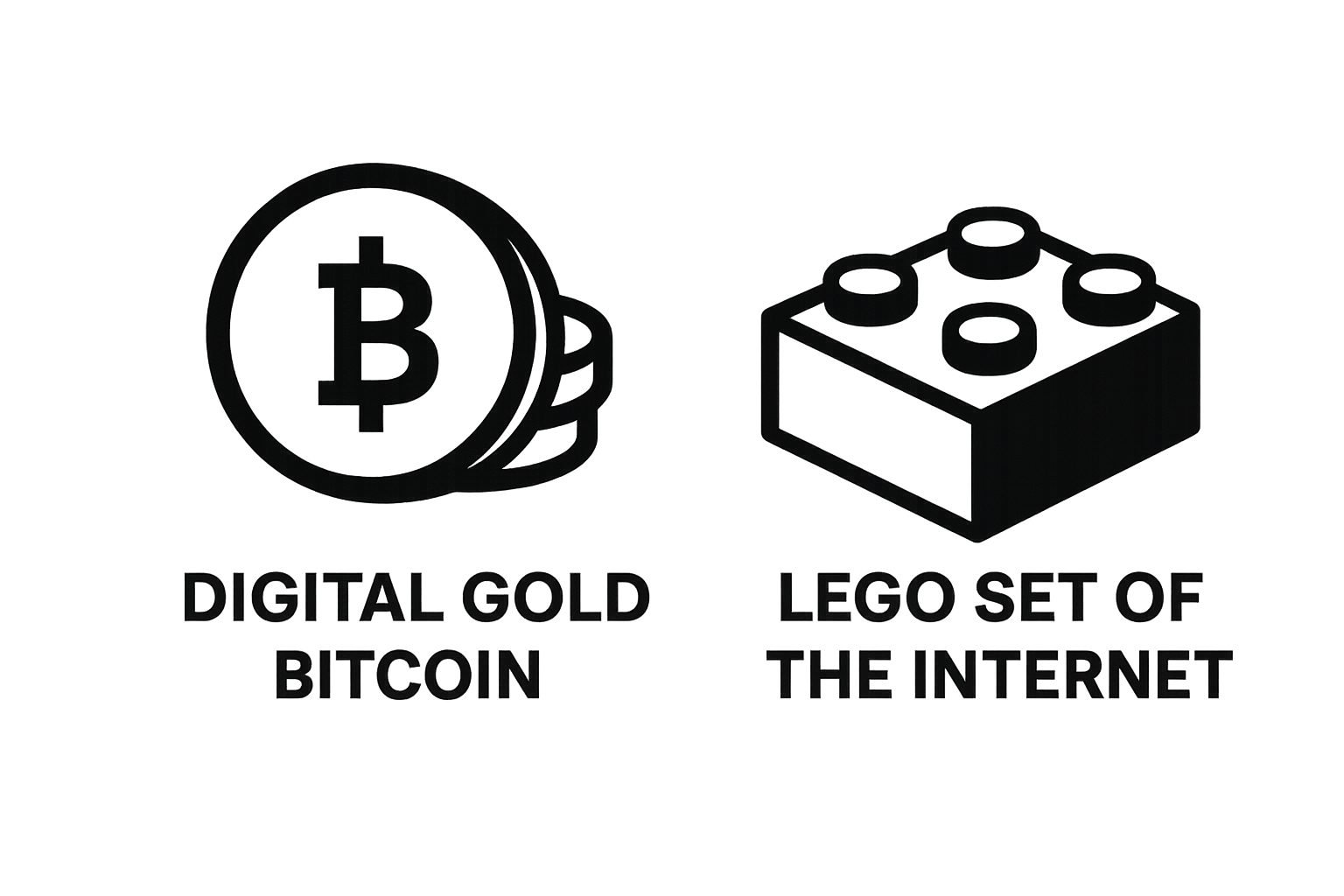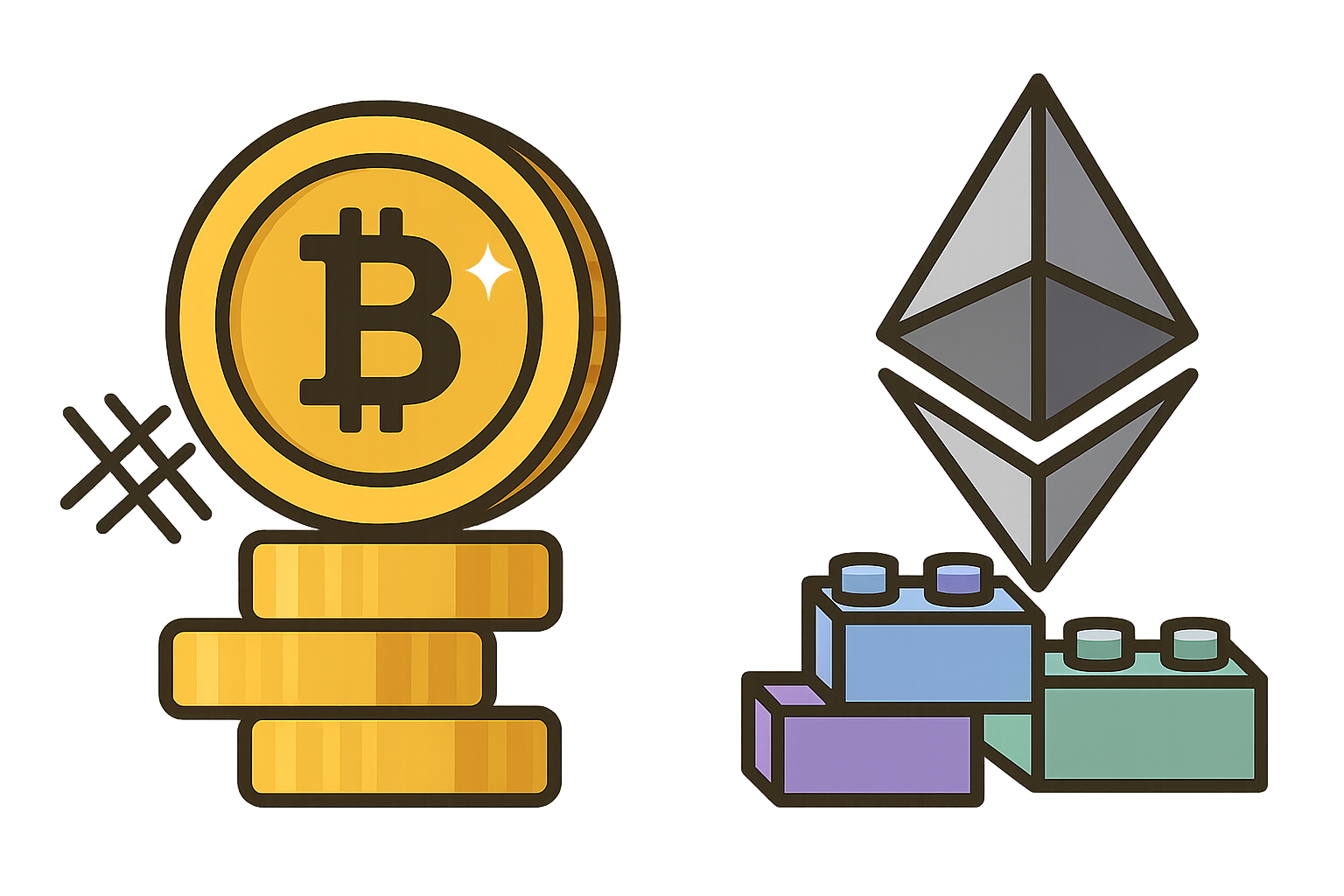Welcome to TechUnder5 — where tech meets simplicity in just under 5 minutes!
Two giants. One goal: to change the way we think about money and the internet. But which one is leading the charge?
Today, we’re comparing Bitcoin and Ethereum — the Coke vs. Pepsi of crypto.
Table of Contents
- Origins and Purpose
- Consensus Mechanisms
- Speed and Performance
- Data and Functionality
- Supply and Scarcity
- Developer Interaction
- Real-World Use Cases
- Conclusion
Origins and Purpose
- Bitcoin was launched in 2009 by the mysterious Satoshi Nakamoto as a peer-to-peer digital currency, aiming to replace cash with a decentralized alternative.
- Ethereum launched in 2015, proposed by Vitalik Buterin, as a programmable blockchain — a platform for smart contracts and decentralized applications (dApps), enabling the creation of entire ecosystems beyond just money.
In short:
- Bitcoin is seen as Digital Gold — a store of value and medium of exchange.
- Ethereum is like a Lego set for the internet — you can build finance apps, games, marketplaces, and more without corporate permission.

Consensus Mechanisms
For decentralized systems to work without a central authority, they need consensus mechanisms to agree on valid transactions.
- Bitcoin uses Proof of Work (PoW) — miners solve complex puzzles to validate transactions and secure the network. It’s highly secure but energy-intensive.
- Ethereum started with PoW but in 2022 switched to Proof of Stake (PoS) via The Merge. Validators stake ETH to propose and validate new blocks — making the process faster and more energy-efficient.
Speed and Performance
- Bitcoin processes a block roughly every 10 minutes.
- Ethereum processes a block about every 12 seconds.
This makes Ethereum much faster, especially for applications like dApps and smart contracts.

Data and Functionality
While both use distributed ledgers and cryptography, they differ in what’s stored and executed:
- Bitcoin: Mostly financial transactions — a secure, global ledger.
- Ethereum: Transactions can include executable code — enabling smart contracts to run directly on-chain, making Ethereum function like a virtual machine.
Supply and Scarcity
- Bitcoin has a fixed supply of 21 million coins. Every 4 years, the reward for mining new coins halves — an event called the halving — increasing scarcity over time.
- Ethereum has no fixed total supply, but after The Merge, a portion of transaction fees is burned. Sometimes, more ETH is burned than created, reducing total supply but unlike Bitcoin it does not have an upper limit.
In simple terms:
- Bitcoin becomes scarcer by design.
- Ethereum is flexible and adaptable in supply.

Developer Interaction
- Bitcoin: Minimal scripting language for security; not meant for complex programs.
- Ethereum: Uses its own language, Solidity, to create and run smart contracts on the Ethereum Virtual Machine (EVM).
Real-World Use Cases
Bitcoin is mainly used for:
- Long-term savings (“digital gold”) : Bitcoin is often compared to gold because it has a limited supply of 21 million coins, making it resistant to inflation. Many investors buy and hold BTC as a hedge against economic instability, much like storing wealth in gold. For example, large companies like MicroStrategy and Tesla have allocated part of their treasury reserves to Bitcoin.
- Direct person-to-person payments without banks : Bitcoin allows you to send money anywhere in the world without going through banks, payment processors, or governments. This makes it especially valuable for people in countries with limited banking access or those facing financial sanctions. For instance, freelancers working globally can receive payments in BTC instantly and securely.
- Protection against inflation and currency devaluation : In countries like Venezuela or Argentina, where hyperinflation erodes the value of local currency, people use Bitcoin to preserve their purchasing power. By storing wealth in BTC, they avoid the risks of rapidly falling local currency values.
Ethereum enables:
-
DeFi — borrow, lend, earn interest without banks : Ethereum powers DeFi platforms like Aave, Compound, and Uniswap, where users can lend their crypto to earn interest, borrow funds without credit checks, or trade assets peer-to-peer. These services are open 24/7, accessible to anyone with an internet connection, and don’t require intermediaries.
-
NFTs & gaming — own and trade digital assets : On Ethereum-based platforms like OpenSea and Axie Infinity, users can buy, sell, and trade NFTs (non-fungible tokens) representing digital art, collectibles, or in-game items. Unlike traditional games, players truly own their assets and can sell or trade them outside the game ecosystem.
-
Smart contracts — self-running programs for trustless agreements : Smart contracts are pieces of code that execute automatically when conditions are met, eliminating the need for middlemen. They are used in everything from decentralized insurance (like Nexus Mutual) to automated royalty payments for artists.
-
Token creation — launch new cryptocurrencies on Ethereum : Anyone can create and deploy their own token on Ethereum using standards like ERC-20 for fungible tokens or ERC-721 for NFTs. Many well-known projects, such as Chainlink (LINK) and Shiba Inu (SHIB), started as Ethereum-based tokens before growing into large ecosystems.
Conclusion
Bitcoin is money. Ethereum is the future of the internet.
They’re built for different purposes but complement each other in the world of Web3.
Which one do you believe in more — the digital gold or the decentralized world computer?
